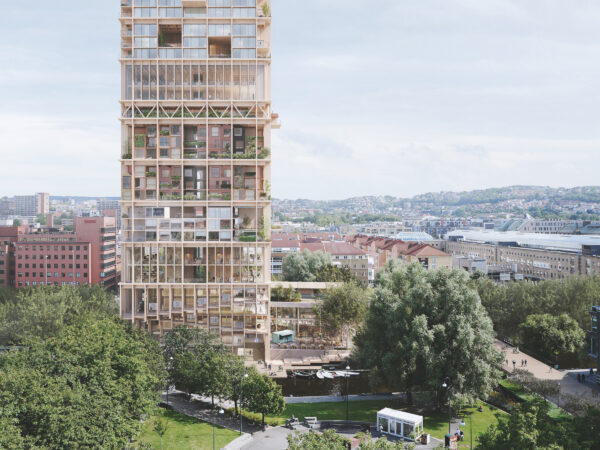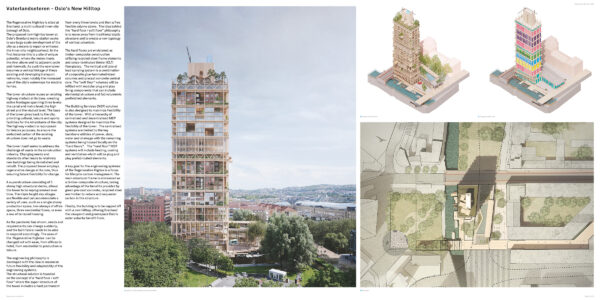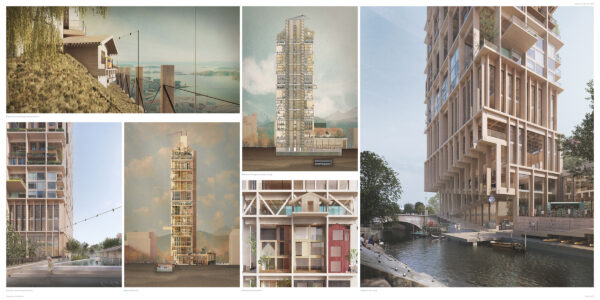Honorable Mention
2022 Skyscraper Competition
Haptic Architects, Ramboll
Tomas Stokke, Shonn Mills
United Kingdom, Singapore
The Regenerative Highrise is sited at Grønland, a multi-cultural inner-city borough of Oslo.
The proposed new highrise tower at Oslo’s Grønland metro station seeks to use large-scale development of the city as a means to repair or enhance the inner-city neighborhood. In the first instance, this is a site of unique potential, where the metro meets the river above and its adjacent cycle and riverwalk. As such the new tower becomes a vertical linkage of these existing and developing transport networks, most notably the increased use of the city’s waterways for electric ferries.
The tower structure reuses an existing highway viaduct at its base, creating active frontages spanning three levels: the canal and metro level; the high street, and the viaduct level. The base of the tower gives back to the city, providing cultural, leisure, and sports facilities for the inhabitants of the city. The highway viaduct is repurposed for leisure purposes, to ensure the embodied carbon of the existing structure does not go to waste.
The tower itself seeks to address the challenge of waste in the construction industry. Changing needs and standards often lead to relatively new buildings being demolished and rebuilt. The proposed tower employs regenerative design at its core, thus ensuring future flexibility for change.
A superstructure consisting of 3-story high structural decks, allows the tower to be reprogrammed over time. The triple-height sky villages are flexible and can accommodate a variety of uses, such as a single-story production space, two stories of office space, three residential floors, or even a row of terraced housing.
As the pandemic has shown, needs and requirements can change suddenly, and the built fabric needs to be able to respond accordingly. The uses of the Regenerative Highrise can be changed with ease, from offices to hotel, from residential to production or leisure.
The engineering philosophy is developed with the idea to maximize future flexibility and adaptability of the engineering systems.
The structural solution is founded on the concept of a “hard floor / soft floor” where the super-structure of the tower includes a hard permanent floor every three levels and then a free flexible volume above. The idea behind the “hard floor / soft floor” philosophy is to move away from the traditional static structures and to create a new typology of vertical urbanism.
The hard floors are envisioned as timber composite construction utilizing recycled steel frame elements and cross-laminated timber (CLT) floorplates. The vertical and lateral load carrying system is a combination of composite glue-laminated/steel columns and a precast concrete central core. The “soft floor” volumes will be infilled with modular plug-and-play living components that can include elemental structure and full volumetric prefinished elements.
The Building Services (MEP) solution is also designed to maximize the flexibility of the tower. With a hierarchy of centralized and decentralized MEP systems designed to maximize the flexibility of the tower. The centralized systems are limited to the key backbone utilities of power, data, water, and drainage with the remaining systems being housed locally on the “hard floors”. The “hard floor” MEP systems will include heating, cooling, and ventilation which will be plug-and-play prefabricated elements.
A key goal for the engineering systems of the Regenerative Highrise is a focus on lifecycle carbon management. The main structural frame is envisioned as a timber-composite structure, taking advantage of the benefits provided by green pre-cast concrete, recycled steel, and timber to reduce and sequester carbon in the structure.
Finally, the building is to be capped off with a new hilltop, offering Grønland the viewpoint and greenspace Oslo’s outer suburbs benefit from.

















